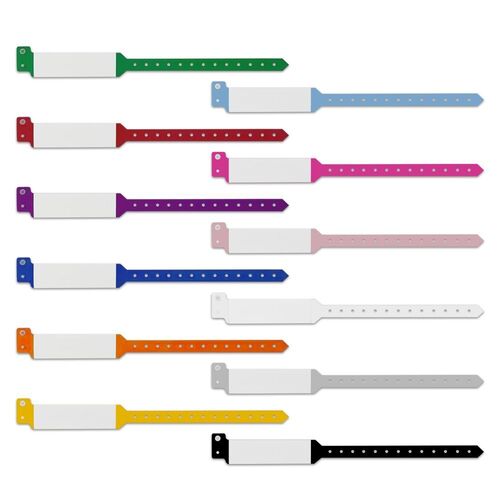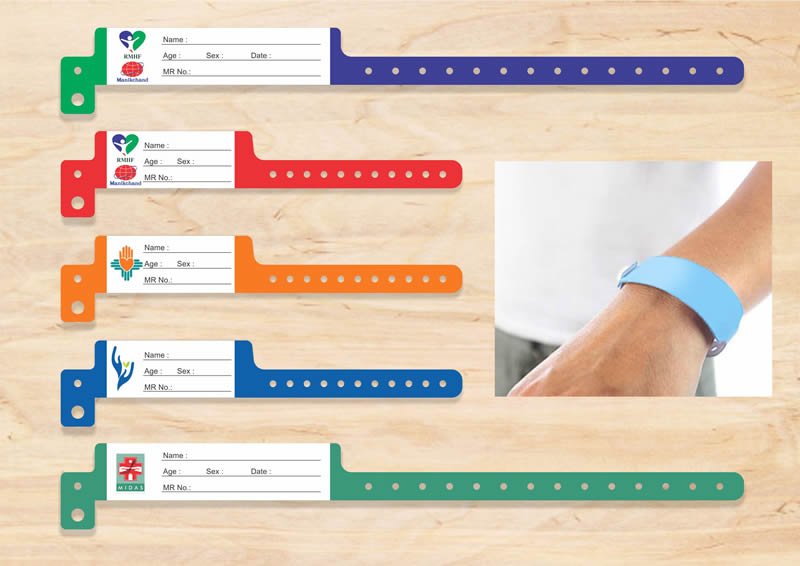Choosing the Right Materials for Your Patient Identification Band: A Step-by-Step Guide
Choosing the Right Materials for Your Patient Identification Band: A Step-by-Step Guide
Blog Article
Exploring the Numerous Sorts Of Patient Identification Band Utilized in Medical Facilities
In the complex globe of medical care, the critical duty of Patient Identification bands typically goes undetected. These bands, varying from easy paper wristbands to innovative RFID bands, create the foundation of Patient safety and security methods, ensuring accuracy in Patient Identification. Yet, the vast variety of these bands, each with its unique advantages and constraints, is often ignored. As we browse via this subject, one might gain insight into the refined intricacies and crucial value of such bands in medical centers.
Comprehending the Relevance of Patient Identification Bands
While they might look like mere accessories, Patient Identification bands play an important role in medical centers. These bands serve as a crucial tool for verifying Patient identification, avoiding clinical mistakes connected to misidentification. The bands normally present important info such as the Patient's name, age, blood group, and any known allergies. They permit medical care experts to rapidly access this important details, thereby helping with prompt and exact clinical therapy. Patient Identification bands likewise aid in simplifying administrative tasks, making sure exact record-keeping and invoicing. Regardless of their simpleness, these bands symbolize the concept of Patient security, a cornerstone of quality wellness care. Without them, the threat of clinical errors, and as a result, Patient harm, might dramatically increase.
Conventional Paper Wristbands: Their Usage and Limitations
Typical paper wristbands have been a staple in Patient Identification across different medical centers. While their use is extensive, they harbor specific restrictions that might affect their efficiency in Patient administration. This section will concentrate on the range of their application and the intrinsic disadvantages connected with their use.
Paper Wristbands: Usage Extent
In the world of Patient Identification, paper wristbands have actually long held an important duty. These bands are generally utilized in outpatient setups, where the Patient's remain is short-lived. Despite developments in innovation, the modest paper wristband continues to be a cost-efficient and dependable service for Patient Identification in different medical care circumstances.
Limitations of Paper Wristbands
Regardless of their widespread usage, paper wristbands are not without their drawbacks. Their physical toughness is just one of the significant limitations. Exposure to water, sweat, or harsh handling can render them unreadable or perhaps trigger them to break down. Additionally, paper wristbands usually do not have the technical capabilities of more modern choices, such as barcoding or RFID chips, restricting their capability to just presenting created details. The lack of ability to upgrade or modify the information on the wristband is an additional imperfection. In addition, if the details is transcribed, clarity can be jeopardized, resulting in prospective misidentification. Lastly, paper wristbands can cause pain or skin inflammation to some people, especially when worn for extensive durations.
Barcoded Wristbands: Developments in Patient Identification
While Patient Identification has long been a critical element of healthcare, the development of barcoded wristbands signifies a considerable jump forward. These bands utilize the simplicity of barcoding innovation, permitting Patient information to be swiftly scanned and accessed. They improve the rate and precision of Patient Identification, minimizing the threat of clinical errors associated to misidentification. Barcoded wristbands are cost-effective, simple to produce, and get rid of handwriting mistakes common with hands-on systems. They are not without limitations. While they use renovations over traditional bands, the barcode can end up being smudged or worn, making it unreadable. Regardless of this, barcoded wristbands remain a necessary tool the original source in modern-day health care setups, symbolizing the intersection of innovation and Patient treatment.
Radio Regularity Identification (RFID) Bands: an Action In The Direction Of Futuristic Health Care
The development of Patient Identification bands has produced the emergence of Superhigh frequency Identification (RFID) Bands (patient identification band). These ingenious tools present crucial advantages for health care facilities, using a much more effective and technologically advanced means of Patient Identification. The application of RFID in medical care is a substantial step towards an extra advanced method to Patient administration and safety
Understanding RFID Bands

RFID Bands: Secret Advantages
Welcoming a future where technology and healthcare merge, radio frequency Identification bands offer several crucial benefits. Mostly, these bands boost Patient safety and security by supplying exact, rapid Identification, consequently lowering clinical errors. RFID bands can store a vast quantity of Patient data, consisting of clinical history and allergic reactions, making it possible for customized care. They additionally enhance administrative jobs, as the automated information entry replaces hand-operated procedures, enhancing efficiency and lowering documentation. RFID bands offer real-time tracking of patients, vital in high-risk atmospheres such as surgical treatment or intensive care. These bands are sturdy and resistant to environmental variables, guaranteeing regular functionality. Generally, RFID bands stand important source for a significant improvement in Patient Identification innovation, profiting both patients and health care providers.
Implementing RFID in Medical Care
These bands offer a seamless way to track and identify people, ensuring their safety and improving effectiveness in therapy procedures. RFID bands minimize clinical mistakes by supplying accurate Patient Identification, which is crucial in preventing misdiagnosis or wrong medication administration. Thus, the execution of RFID bands is a considerable action towards enhancing Patient safety and security and health care distribution.

Color-Coded Wristbands: Assisting in Quick and Accurate Diagnosis
In the bustling setting of a clinical facility, color-coded wristbands have actually emerged as vital devices for swift and accurate Identification of an individual's medical condition. These wristbands, put on by individuals, carry specific shades that correspond to various medical conditions or standings. This system is developed to supply instant aesthetic hints to medical care suppliers, enhancing Patient safety and care top quality.
Techniques for Reliable Application and Monitoring of Patient ID Bands
Accomplishing optimal usage of Patient Identification bands requires a well-structured strategy for their execution and administration. Patient education is also crucial; people should recognize the function of the bands this article and the need for their continuous wear. It's important to have a back-up plan in area, such as barcode scanning or biometrics, to guarantee that Patient Identification is never ever compromised.
Final thought
Patient Identification bands are essential in medical centers to guarantee safety and security and accuracy. Typical paper, barcoded, RFID, and color-coded wristbands each hold distinct benefits, varying from cost-effectiveness to sophisticated information storage and immediate clinical notifies. Efficient implementation and administration of these bands can dramatically decrease clinical mistakes, boost effectiveness, and boost overall Patient care. Hence, understanding and utilizing these Identification tools is extremely important for maintaining high requirements in healthcare.
These bands, varying from simple paper wristbands to advanced RFID bands, develop the backbone of Patient safety protocols, guaranteeing precision in Patient Identification.The evolution of Patient Identification bands has actually brought about the emergence of Radio Frequency Identification (RFID) Bands. On the whole, RFID bands stand for a substantial advancement in Patient Identification modern technology, profiting both individuals and health care carriers.
RFID bands lower medical errors by providing accurate Patient Identification, which is vital in stopping misdiagnosis or wrong medication administration. Patient education and learning is likewise important; clients should understand the objective of the bands and the demand for their continuous wear.
Report this page